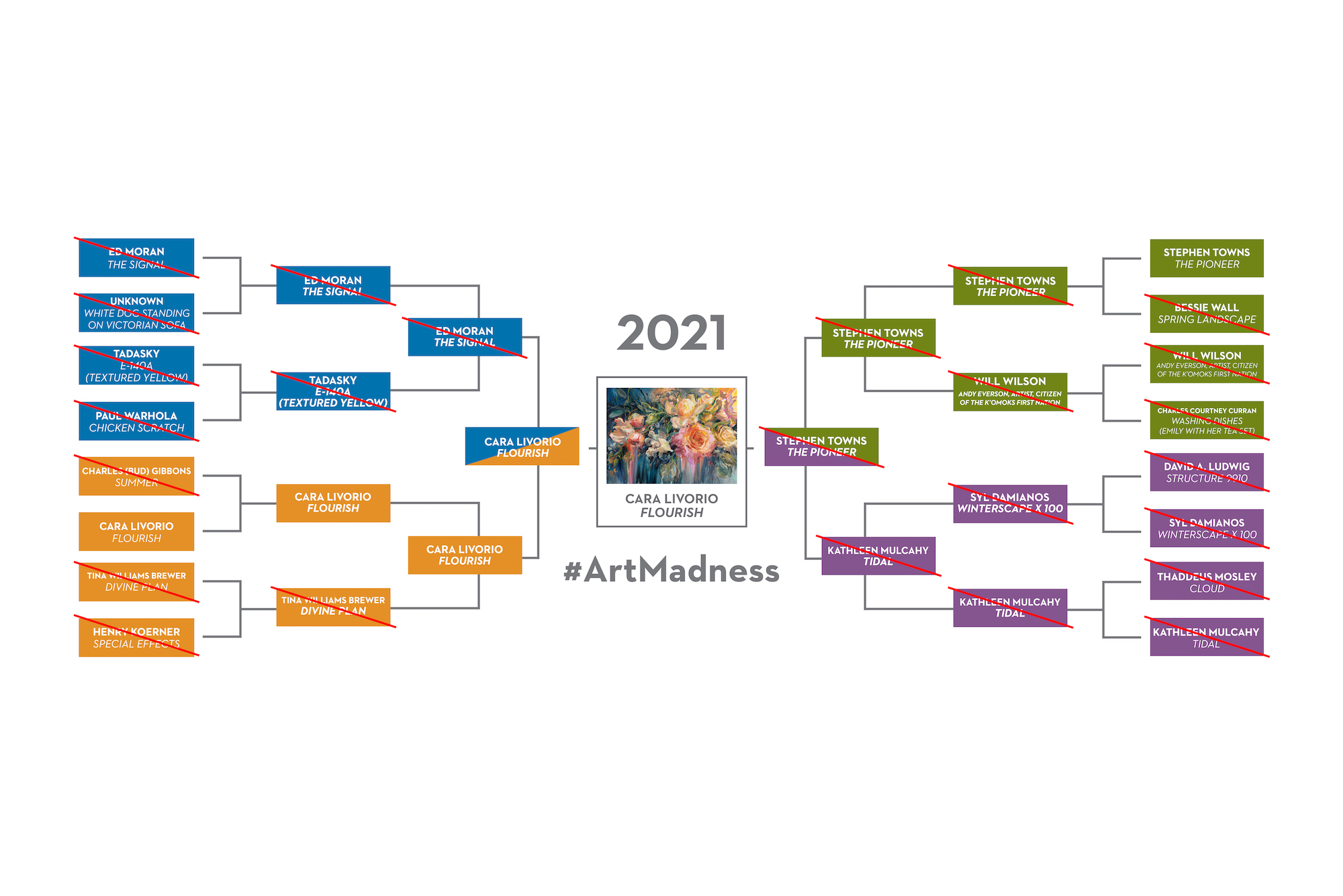2nd Annual #ArtMadness Tournament
It’s that time of year again: #MarchMadness, and another #ArtMadness Tournament on the Museum’s Instagram! This year our Tournament pits 16 artworks, nominated by Museum staff members, against each other. The artworks nominated are personal staff favorites, recent acquisitions and quite a few of them are even on view in the galleries!
Last year’s Art Madness Champion was Edward Moran’s The Signal, that won with 60% of the final vote, and The Signal has been nominated again. Will The Signal be a repeat champion or will another artwork become the new champ? Only YOU can decide by casting your vote!
Your votes will determine the Museum’s Elite Eight, Final Four, and the ArtMadness Champion!
How to Participate
Download your Art Madness Bracket, print it and fill it out. Vote on our Instagram (@westmorelandmuseum) who you think should advance to the Elite Eight and ultimately which work of art should be the #ArtMadness Champion!
March 27- 28: Sweet Sixteen Instagram Story – Vote on which works will move onto the Elite Eight.March 31 – April 1: Elite Eight Instagram Story – Vote on which artworks will move onto the Final Four.April 3- 4: The Final Four Instagram Story – Vote on which artworks will move onto the Championship.April 6-7: The Art Madness Championship Instagram Story – Vote on which artwork you think should be the Art Madness Champion!- April 8: #ArtMadness Tournament Winner Announced.
Make sure you follow our Facebook (@TheWestmoreland) for updates about the Art Madness Tournament and see how your bracket compares!
Art Madness Champion
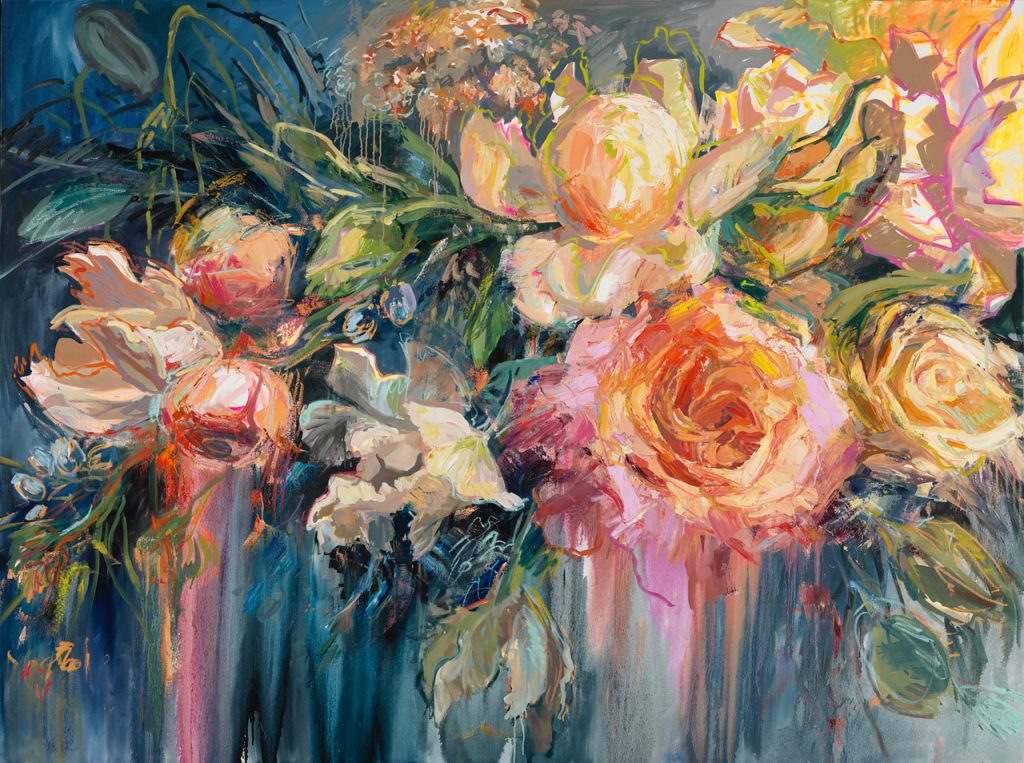
After a crazy Art Madness Tournament featuring a diverse set of 16 artworks from our permanent collection, your 2021 Art Madness Champion with 54% of the final vote is Flourish by Cara Livorio! Livorio’s Flourish is currently on view in Surface-Texture-Materials until May 9. Thanks to all those who voted and participated in this year’s Art Madness Tournament.
Art Madness Championship Faceoff
Flourish by Cara Livorio – Advances to the Championship with 52% of the vote, defeating last year’s champion Edward Moran’s The Signal.

“I love the larger than life flowers that just draw you in and all the gorgeous colors! Cara is a talented local artist and all of her work is stunning.” – Claire Ertl
Livorio is the owner of Artissima, an art school, gallery and art boutique, in Fox Chapel. Flourish is part of the artist’s series, B(L)OOM!, an exploration of dynamic florals or “un-still lives” in which she seeks to elevate the florals into an expression of their living energy.
The Pioneer by Stephen Towns – Advances to the Championship with 76% of the vote, defeating Kathleen Mulcahy’s Tidal.
Nominated by Director of Marketing & PR Claire Ertl
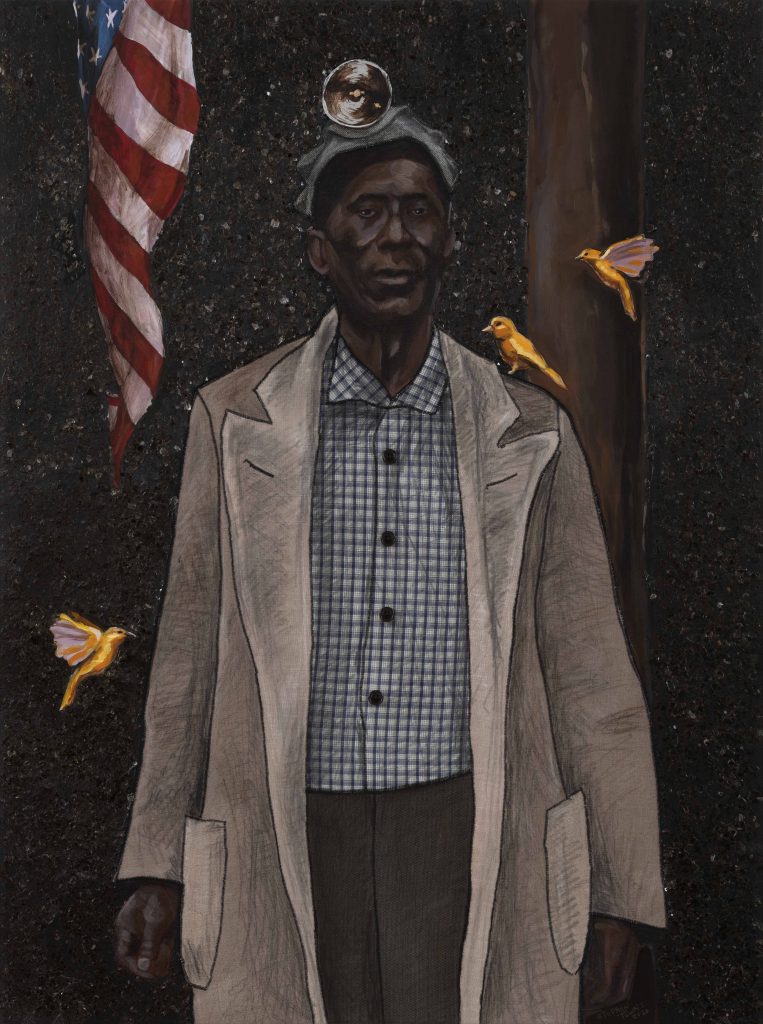
“I nominate Stephen Towns The Pioneer. It’s one of the newest works to be added to collection and I feel that his portraits are so powerful.” – Claire Ertl
Nationally known Baltimore painter and fiber artist, Stephen Towns explores how American history influences contemporary society through his work. Drawing visual inspiration from medieval altarpieces, nineteenth-century photography, and Dutch wax print fabrics, in addition to African American story quilts, Towns work examines the constructs of race and its effects on society. Towns’ mixed media work “The Pioneer” is from his Coal Miner series, a new body of six paintings created for his forthcoming 2022 exhibition “Stephen Towns: Declaration and Resistance” at The Westmoreland.
Eliminated Contenders
The Signal by Edward Moran – Eliminated during the Final Four round by Cara Livorio’s Flourish.
Nominated by Manager of Communications Maggie Geier
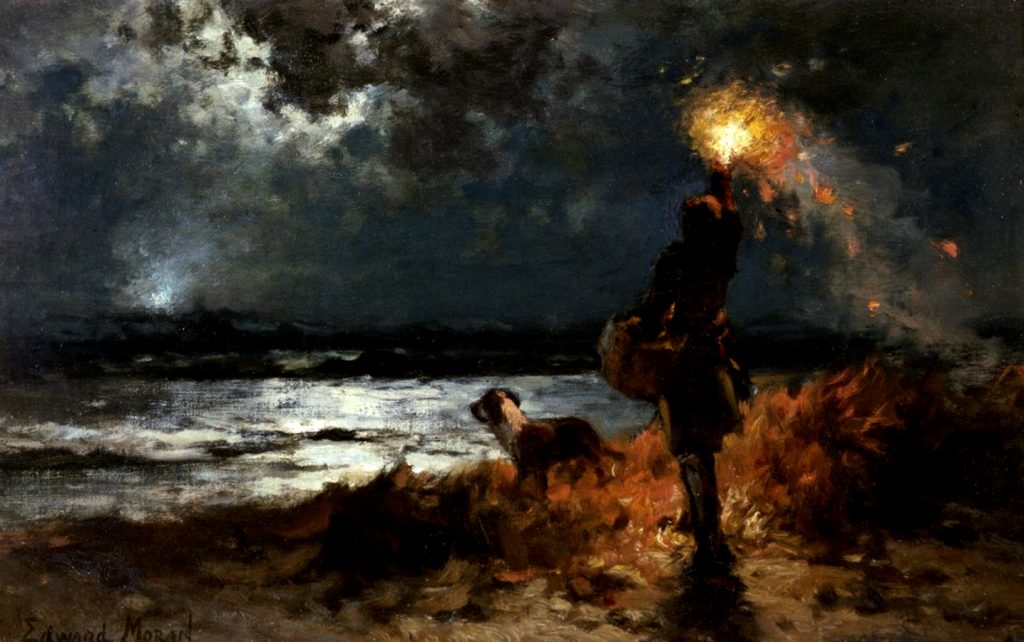
“Well, I nominated this work last year because I love how Moran depicts the moonlight, torch, and ship light in the distance. I’m nominating it again this year because it won last year!” – Maggie Geier
English-born artist Edward Moran is known for his Romantic seascapes and marine paintings, but may be most famous for his series of 13 historical paintings of United States marine history. He emigrated to the United States in 1844 and lived in Philadelphia, where he studied with the artist James Hamilton. Moran was a member of the National Academy of Design, the American Watercolor Society, and the Lotus Club.
Tidal by Kathleen Mulcahy — Eliminated during the Final Four round by Stephen Town’s The Pioneer.
Nominated by Chief Curator Barbara Jones
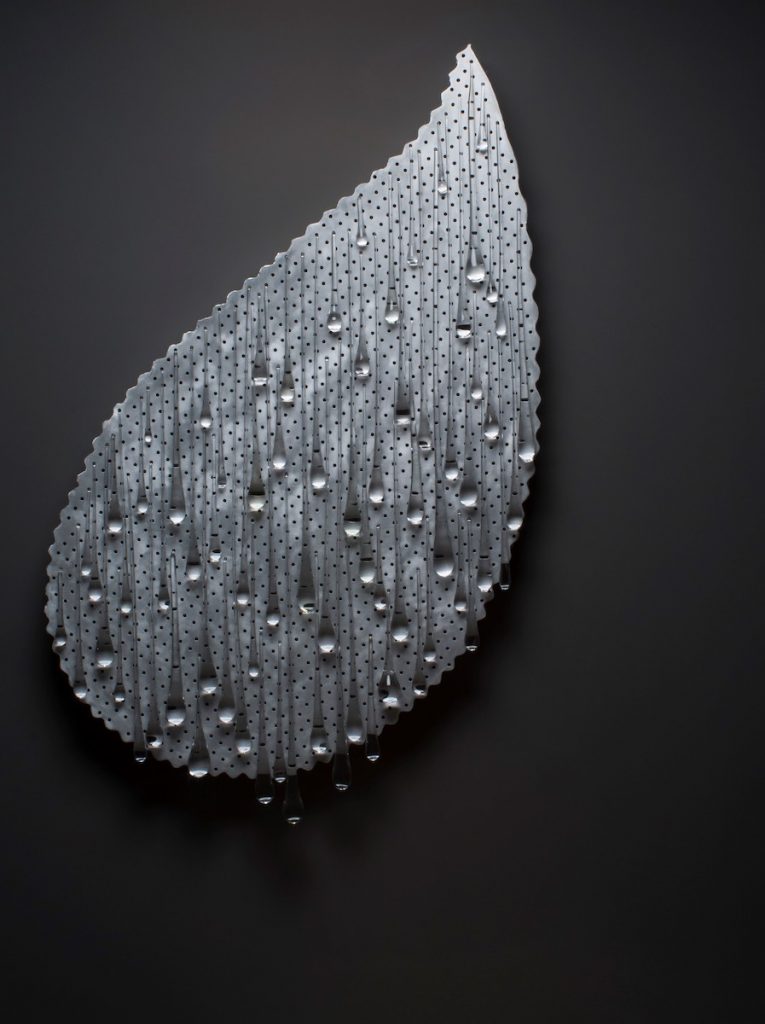
“Kathleen Mulcahy’s glass and aluminum Tidal is a wonderful combination of materials. The transparency of the glass reflects the abraded surface of the aluminum and the materials become one.” – Barbara Jones
Kathleen Mulcahy has been creating works of art from glass and mixed media for five decades. Having a Masters of Fine Arts in glass sculpture and three-dimensional design from Alfred University, she directed glass studio programs at Bowling Green State University in Ohio and Carnegie Mellon University in Pittsburgh then went on to develop the Pittsburgh Glass Center with her husband and partner, artist Ron Desmett. During this time, her own work — installation pieces, cast glass, blown glass objects — evolved into unique and poignant statements.
E-140A (Textured Yellow) by Tadasky – Eliminated during the Elite Eight by Edward Moran’s The Signal.
Nominated by Accounting Manager Gina Falcon

“I would like to nominate the new Tadasky painting that we just purchased. It reminds me of the sun, which I am very anxious to see again!”- Gina Falcon
Born in 1935 Tadasuke Kuwayama, or Tadasky, as he would become known, was the son of a prominent craftsman in Nagoya, Japan. Emigrating to the United States in 1961, Tadasky settled in NYC where he supported himself financially using carpentry skills honed in Japan. By the mid 1960s, his concentric circles were identified with the Op Art movement and featured in numerous solo and group exhibitions. Following travels throughout the Southwestern United States in 1968, Tadasky’s work changed significantly; his paintings were now capable of suggesting the sensation of the sun’s intense heat & light.
Divine Plan by Tina Williams Brewer – Eliminated during the Elite Eight, was bested by Cara Livorio’s Flourish.
Nominated by Director of Marketing & PR Claire Ertl

“I believe it is the only contemporary fabric/quilting/textile work in our collection and by an important local female artist. Also, March is Women’s History Month, which had me thinking about the wonderful women artists that we have in our collection!” – Claire Ertl
Internationally renowned artist and storyteller, Tina Williams Brewer creates story quilts inspired by African and African American spirituality, history and culture, and is motivated by issues focusing on family, women, and spirituality. The Museum was fortunate to add Brewer’s hand-pieced and hand-quilted “Divine Plan,” a mixed media story quilt referencing Mother Nature and the celestial world, to the permanent collection in 2020 through a gift of the Westmoreland Society.
Andy Everson, Artist, Citizen of the K’omoks First Nation, by Will Wilson – Eliminated during the Elite Eight, was defeated by Stephen Town’s The Pioneer.
Nominated by Graphic Designer Jackie Brightwell
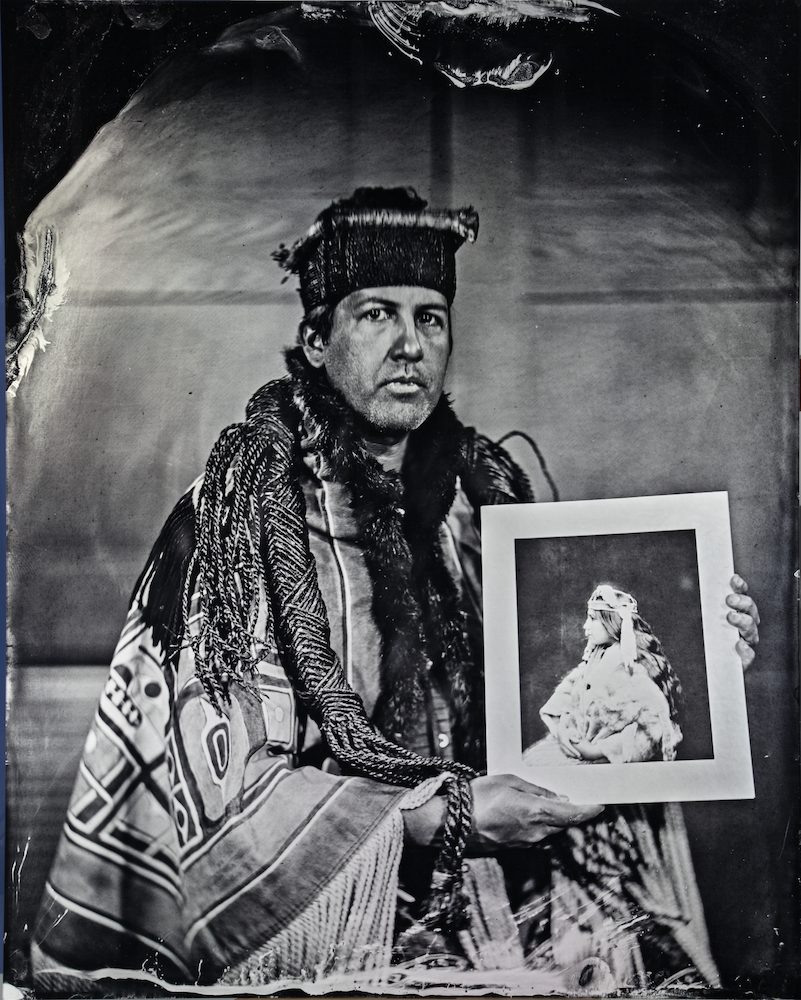
“Two words: Talking Tintype. This artwork is a must-see in the Museum’s current exhibition, Pattern Makers.” – Jackie Brightwell.
Contemporary Native American artist Will Wilson’s, a citizen of the Navajo Nation Critical Indigenous Photographic Exchange (CIPX) series features portraits of indigenous artists, art professionals, government leaders as well as the general public. A selection of these works have a virtual reality component allowing the viewer to hear the sitters in portrait speak about their lives. Wilson says of the series that it works to “supplant Curtis’ settler gaze . . . with a contemporary vision of Native North America.” We are fortunate to have one of Wilson’s CIPX works now in the Museum’s permanent collection – “Andy Everson, Artist, Citizen of the K’omoks First Nation,” 2017
Winterscape x 100 by Syl Damianos – Eliminated during Elite Eight, fell to Kathleen Mulcahy’s Tidal.
Nominated by Chief Curator Barbara Jones
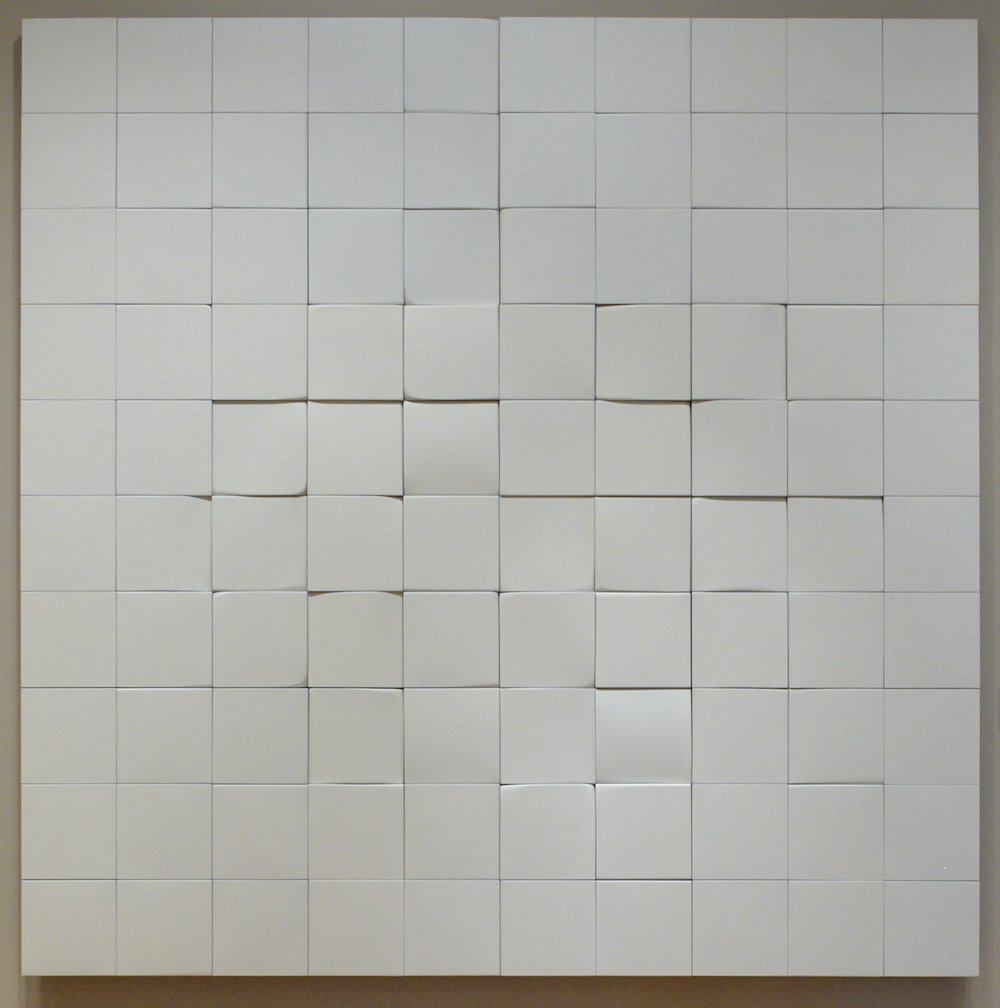
“I gravitate to minimalist works of art and Syl’s Winterscape x 100 is exactly that. The scale of his compositional grid of 10 rows of 10 10-inch squares draws you in, offering a place for contemplation.” – Barbara Jones
Syl Damianos, who lives in Edgewood, has had a dual career in art and architecture for nearly a half century. He received a bachelor’s in architecture, with honors, from Carnegie Institute of Technology (now Carnegie Mellon University) and was a Fulbright Scholar at the Technological Institute of Delft, the Netherlands. Following his internship and association with Celli-Flynn, Architects and Engineers, he co-founded his first firm, Damianos+Pedone, in 1967. It transitioned, over the years, to become Damianosgroup. Damianos is also an artist. He works in a range of materials—canvas, concrete, metal, wood—and his expertly crafted works of art reflect his attention to detail and focus on precision, both of which are significant features of his architecture.
White Dog Standing on Victorian Sofa by Unknown – Eliminated during the Sweet Sixteen. Fell to the returning champ, Edward Moran’s The Signal.
Nominated by Graphic Designer Jackie Brightwell
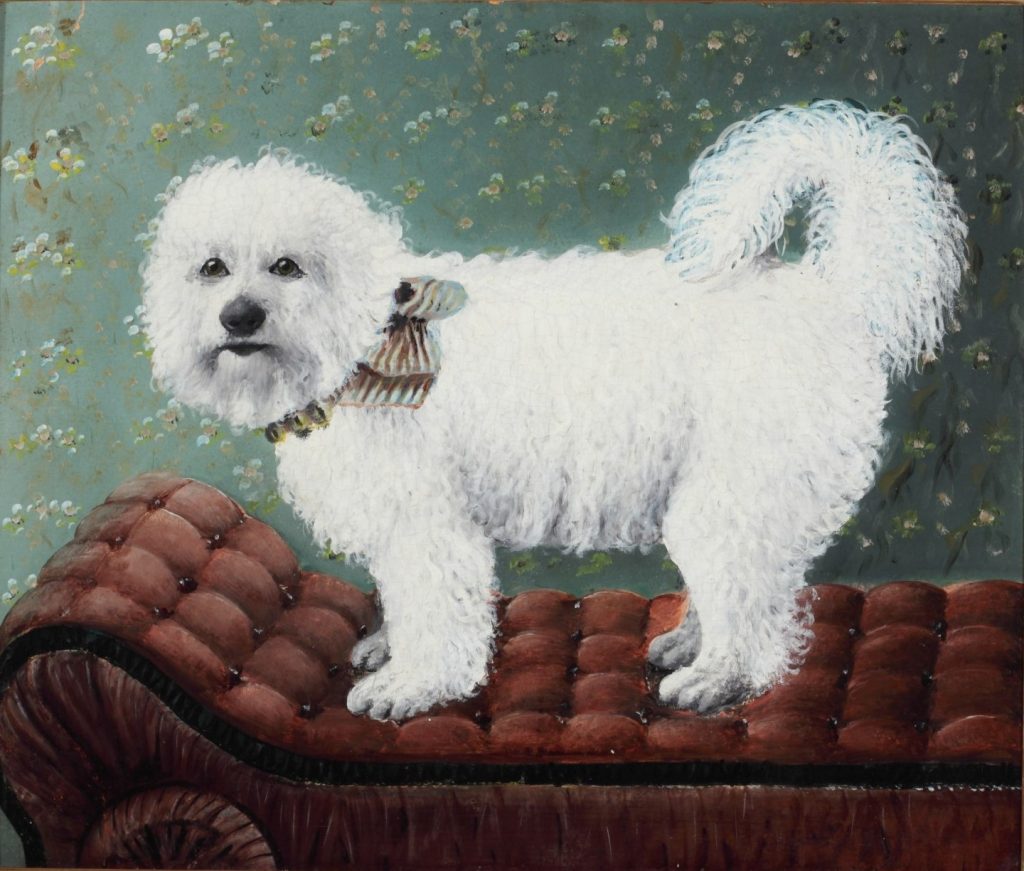
“Simply put, this artwork has it all – Cute Dog? Check. Nice couch? Check. Floral Wallpaper? Check.” – Jackie Brightwell.
This painting by an unknown artist is a visitor favorite, garnering many selfies with families. The curly white-haired dog in the work has also been nicknamed Wintston by Alora Chateaux and Tootsie Snyder during a Drag Queen Art Critique.
Chicken Scratch by Paul Warhola – Eliminated during the Sweet Sixteen
Nominated by Graphic Designer Jackie Brightwell.
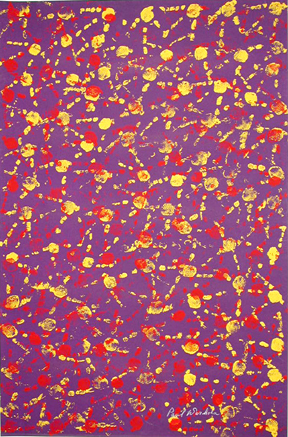
“Not only is it a colorful, fun pattern, but it was made by dipping chicken feet in brightly colored paint, then dabbing them on the canvas. Chicken feet!” – Jackie Brightwell
Born 1922 in Pittsburgh, Paul Warhola, the elder brother of Pop artist Andy Warhol, started painting after Andy’s death in 1987. “I’m going to get the chickens to paint for me,” he told a journalist in 1989. Ultimately, Warhola used frozen chicken feet as a stamp to print the patterned ground for these works.
Summer by Charles W. (Bud) Gibbons – Eliminated during the Sweet Sixteen
Nominated by Employee Benefits Manager Sarah Rowe
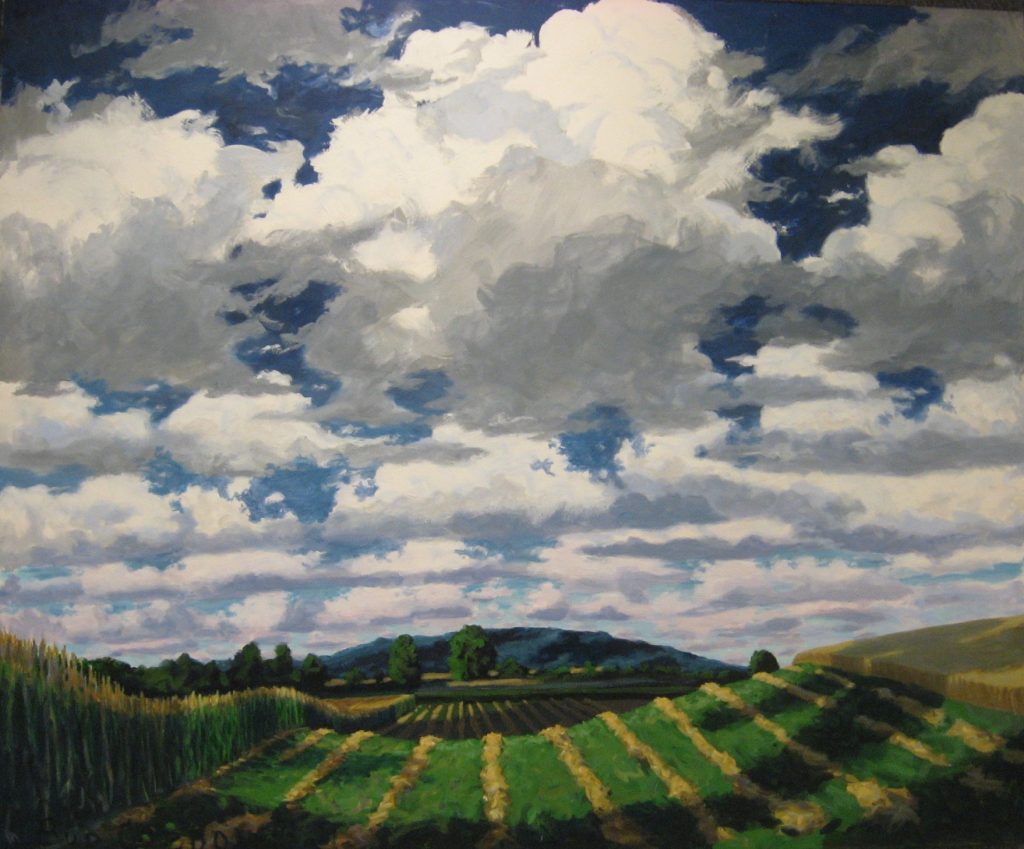
“I would like to nominate Summer by Charles (Bud) Gibbons. This painting gives me hope for sunny, warm days ahead!” – Sarah Rowe
Commissioned between 1991 and 1993, Summer is one of four similarly sized paintings that comprise the series ‘Four Seasons’ in the Museum’s permanent collection. Artist Charles W. Gibbons served as Professor of Art at Pennsylvania State University, New Kensington Campus for over thirty years, and was named a professor emeritus of visual arts at Penn State New Kensington in 2014. His preferred method of painting is “en plein air,” which is French for “in the open air,” and has painted American landscapes as well as places around the world. He has exhibited both regionally and nationally and his work is in numerous public and private collections.
Special Effects by Henry Koerner – Eliminated during the Sweet Sixteen
Nominated by Facilities Manager Brian Jones
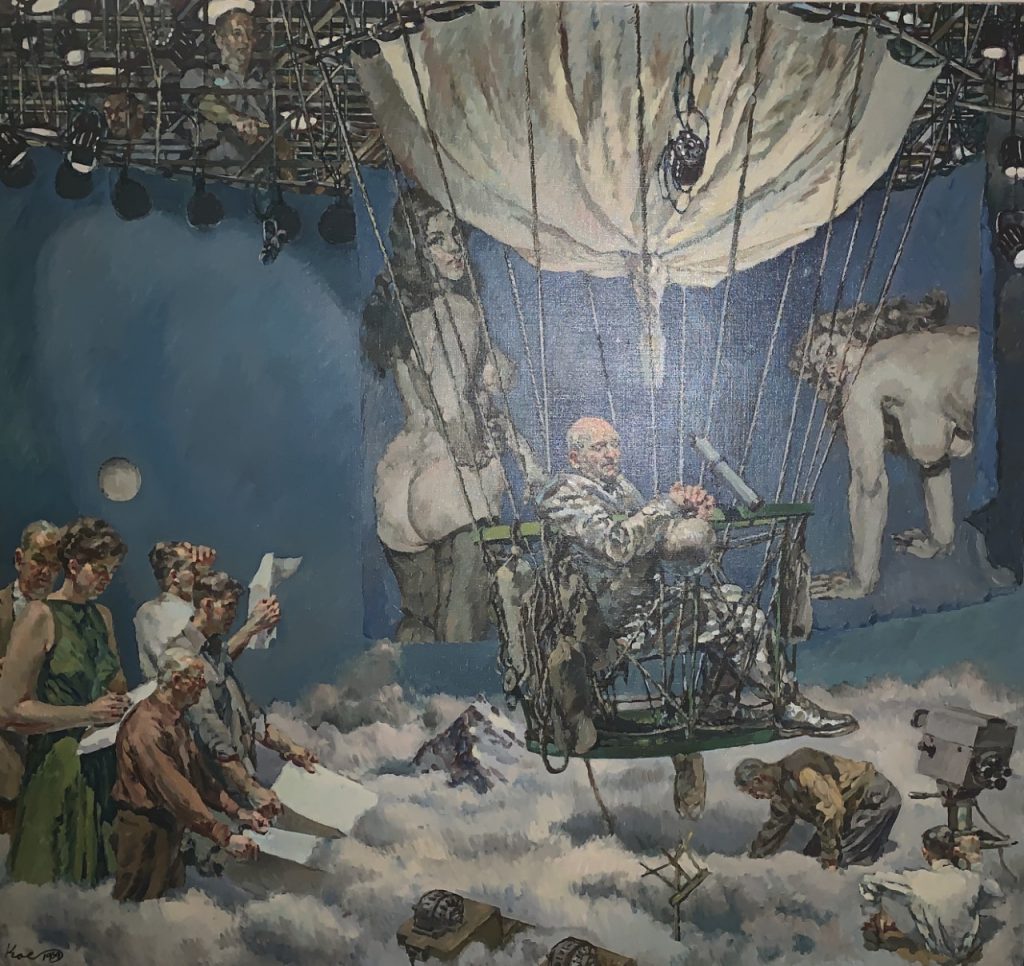
“Fantasy and Reality…. The basis of the entertainment industry encapsulated in a painting. What’s not to love about this piece?” – Brian Jones
Austrian born painter Henry Koerner was born in Vienna in 1915 to Jewish parents and trained there as a graphic designer. After Hitler came to power, he immigrated to the Unites States and enlisted in the U.S. Army. He began painting in 1943 and during the Nuremberg Trials sketched war criminals. Between 1955 and 1967, Koerner painted over 50 Time Magazine covers and became known for his early Magical Realist works of the late 1940s.
Spring Landscape by Bessie Wall – Eliminated during the Sweet Sixteen
Nominated by Director of Advancement Rhonda Madden
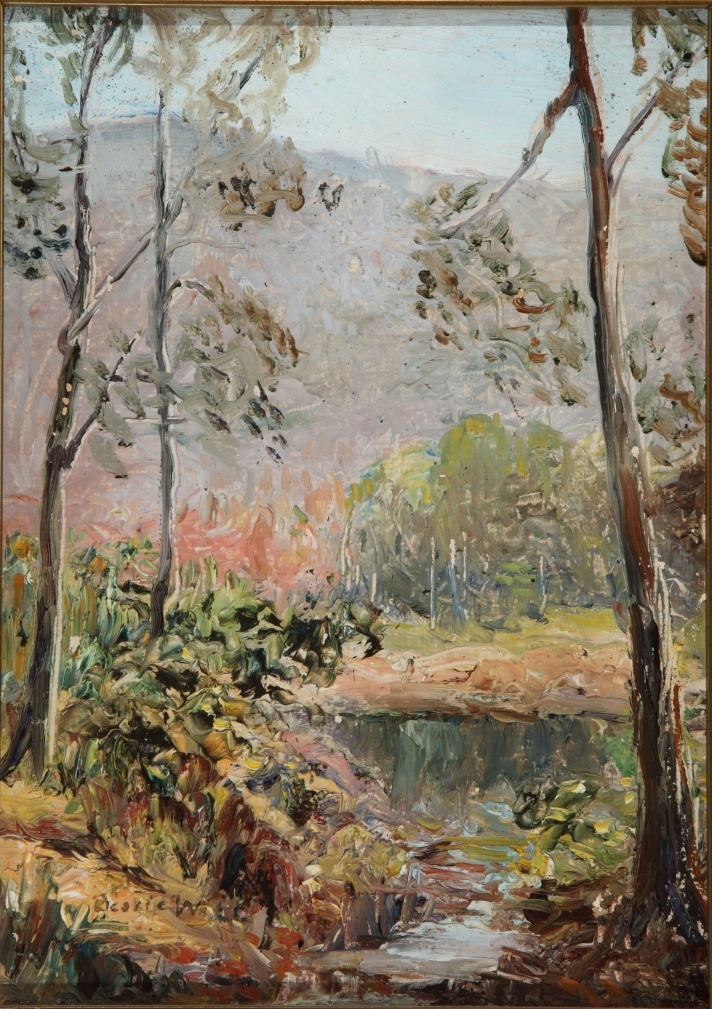
“I’m nominating this painting because I love the pale salmon colored strokes that stand out and express the hope that comes with spring. I also like that the artist Bessie Wall earned recognition for her own gifts in light of her father and brother’s success.” – Rhonda Madden.
Bessie Wall, daughter of Alfred S. Wall, the Pittsburgh painter, and the niece of William Coventry Wall, was born Sarah Elizabeth Wall on October 13, 1872 in Woods Run, Allegheny County, Pennsylvania. She was taught how to paint by her father and accompanied him and her uncle to Scalp Level, PA, a popular destination for Pittsburgh painters of the late 19th century and early 20th century.
Washing Dishes (Emily with Her Tea Set) by Charles Courtney Curran – – Eliminated during the Sweet Sixteen
Nominated by Chief Financial Officer Suzanne Wright
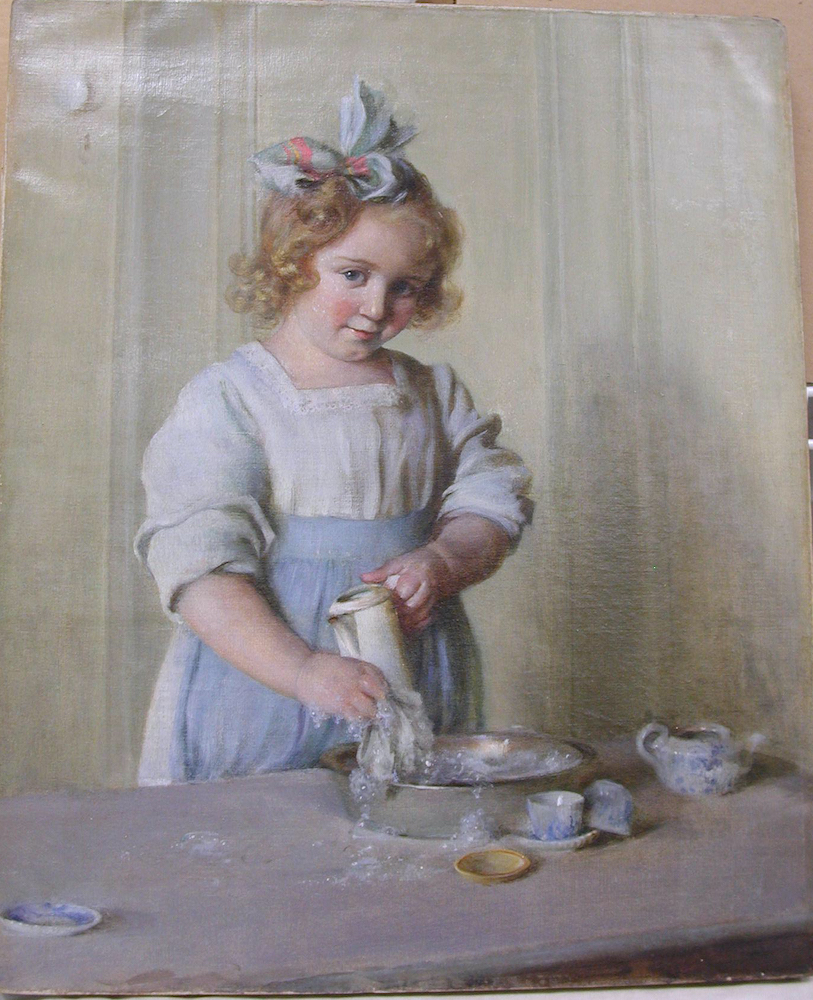
“I love the Charles Courtney Curran because as the oldest daughter of a big extended family, I washed many, many dishes for holidays and my favorite cousin, Peggy would help and this beautiful picture looks so similar to Peggy so always nice to remember those days.” – Suzanne Wright
Born in 1861, Curran was a native of Kentucky and moved in 1881 to New York City, where he attended the National Academy of Design. An Impressionist figure, genre, and landscape painter, Curran became known as a prolific artist who created light-filled paintings, often of young women.
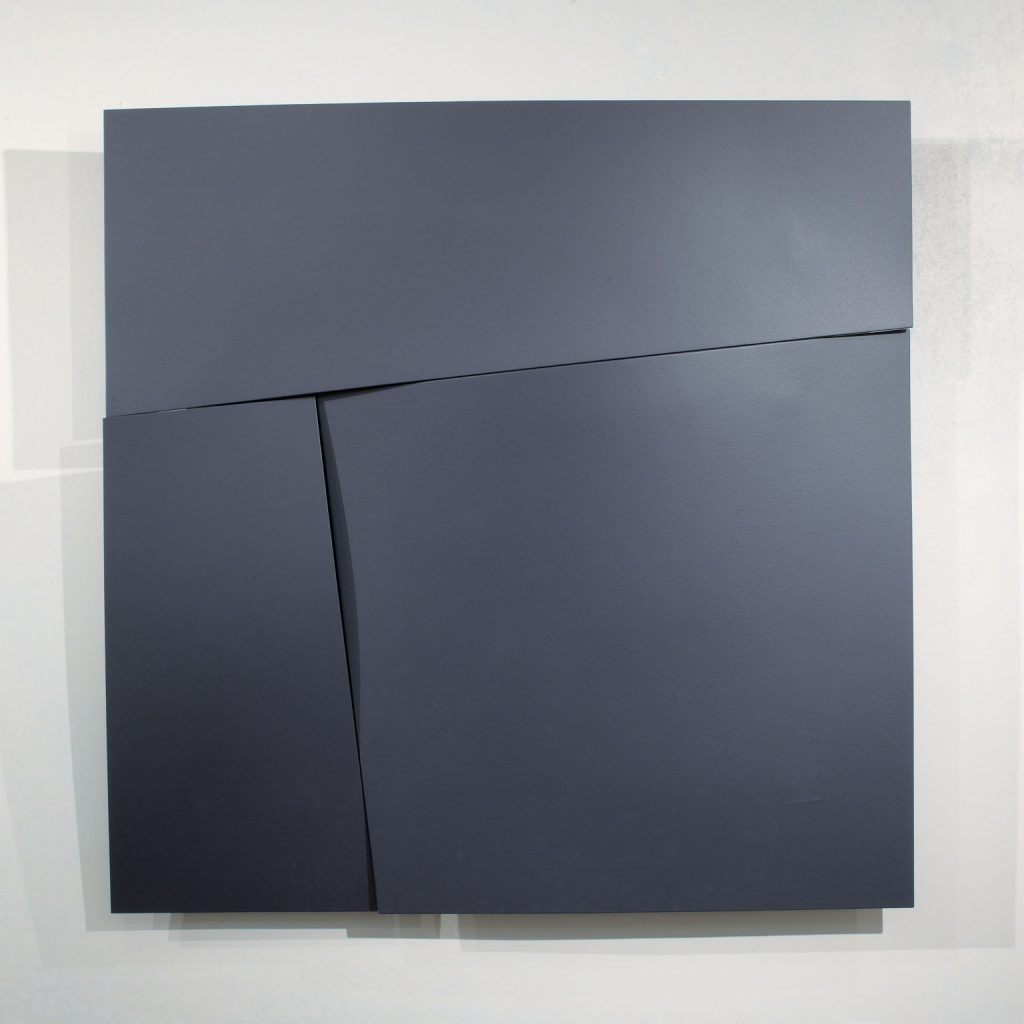
Structure 9910 by David Ludwig – Eliminated during the Sweet Sixteen
Nominated by Chief Curator Barbara Jones
“David was my partner for 15 years and I always admired his methodical and precisionist approach to his work. The rich color, subtle surface texture and movement of the planes of Structure 9910 is especially meditative to me.” – Barbara Jones
Born in 1946, David Ludwig was a local sculptor and educator. Ludwig taught at Saint Vincent College, Latrobe, and at Westmoreland County Community College, Youngwood, and also collaborated on the 1997 yew maze garden, “Labyrinth,” for the Pittsburgh Cultural Trust’s 7th Street and Penn Avenue parklet. Structure 9910 is an example of his decades-long commitment to exploring formal variance through alteration of a master shape — the square.
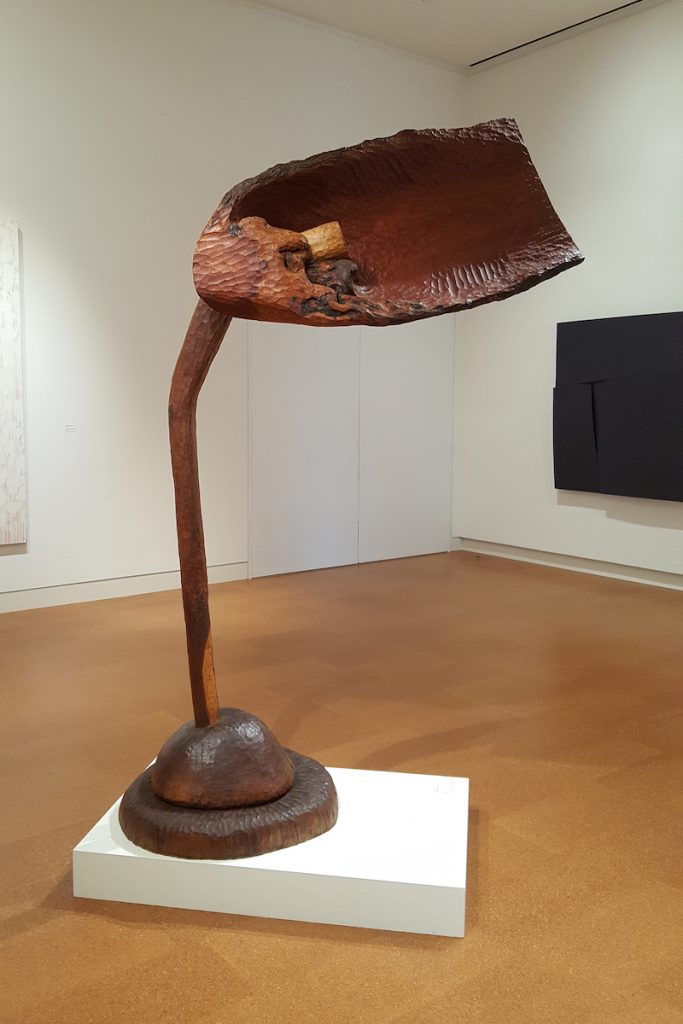
Cloud by Thaddeus Mosely — Eliminated during the Sweet Sixteen
Nominated by Chief Financial Officer Suzanne Wright
“I love Thad Mosley’s Cloud because it always feels like I am under a cool tree when I am beneath it and from afar, it reminds me of my Dad, old and weathered, but had a lot of stories hidden in them that just needed time to be revealed.” – Suzanne Wright
Mosley’s “Cloud,” on view in our 20th Century Gallery, showcases his expertise in manipulating form, weight, and space. Mosley is a self-taught African American sculptor who gives new life to “at hand” materials such as stone from demolished buildings, scrap yard metal, and most often, logs from the trees of western Pennsylvania. Drawing with hammer and chisel, he embarks on a journey of sculptural improvisation. What begins as a suggestion in chalk directly applied to the wood evolves into an elegant balance of space and structure. His work evokes the spirit of African art and American jazz, while revealing the influences of Constantin Brancusi and Isamu Noguchi.
